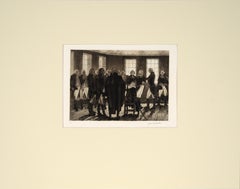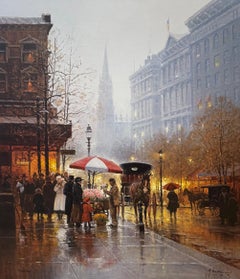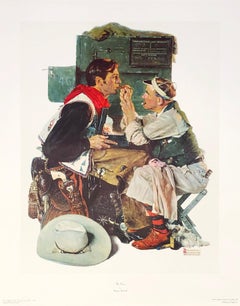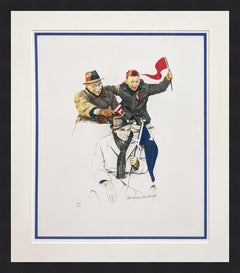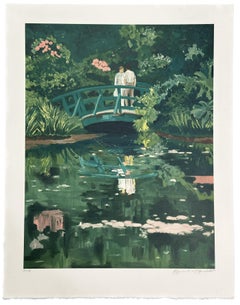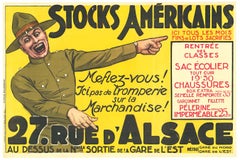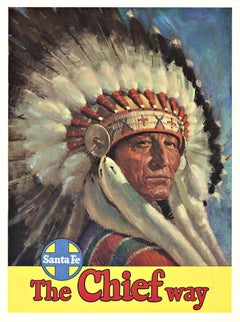American Impressionist Prints and Multiples
to
105
110
70
78
48
29
Overall Width
to
Overall Height
to
21,223
18,883
10,799
5,985
5,506
2,678
1,553
1,410
1,247
831
805
429
344
193
19
18
13
13
11
1
21
303
28
5
29
33
24
8
12
6
50
52
12
1
179
151
5
175
96
46
46
44
43
36
33
29
23
23
22
19
16
13
13
12
12
12
11
129
103
80
43
34
96
55
350
Style: American Impressionist
Original Carthusia Capri - Italy, perfume vintage poster
Located in Spokane, WA
Original vintage poster Carthusia Capri (Italy) perfume vintage poster. Artist: Mario Laboccetta. "CARTHUSIA I PROFUMI DI CAPRI" Size 26.5" x ...
Category
1960s American Impressionist Prints and Multiples
Materials
Offset
Lovers in Monet's Garden Signed Limited Edition Lithograph
By Tony Bennett
Located in Rochester Hills, MI
Tony Bennett
Title: Lovers in Monet's Garden
Lithograph
Signed and Marked PP 1/10 ( Printers Proof )
Paper Size: 30" x 24" inches
Image Size : 25" x 20" inches
Anthony...
Category
1980s American Impressionist Prints and Multiples
Materials
Lithograph
'Grand Central, Night' — 1920s New York City Realism
Located in Myrtle Beach, SC
Walter Tittle, 'Grand Central Night', drypoint, edition not stated, c. 1920s. Signed in pencil. Titled, and annotated '36.00' and with the inventory numb...
Category
1920s American Impressionist Prints and Multiples
Materials
Drypoint
Original "Stocks Americains" vintage French poster horizontal format
Located in Spokane, WA
Original “Stocks Americans” vintage poster. Linen backed in very good condition, ready to frame. No paper loss, no fold marks, clean and bright. Distress on one letter “S” in A...
Category
Mid-20th Century American Impressionist Prints and Multiples
Materials
Lithograph
$558 Sale Price
20% Off
Santa Fe The Chief Way original American railroad poster
Located in Spokane, WA
Original Santa Fe The Chief Way vintage railroad travel poster. Archival linen backed in very fine condition, ready to frame. Most of the Santa Fe Railway posters feature American Indians, but this poster features the big boss, The Chief! The poster has about a 1" white border around the entire image, the linen backing is not counted in the poster's measurement.
Several of the trains were named "Chief" which includes the San Francisco Chief, Texan Chief, Kansas City Chief...
Category
1940s American Impressionist Prints and Multiples
Materials
Offset
$759 Sale Price
20% Off
FLOWERS - Exhibited in 1997 Smithsonian Monotype Exhibition
By Karl Yens
Located in Santa Monica, CA
KARL YENS (1868 – 1945)
(FLOWERS) 1919
Color monotype signed, dated and annotated: “monotype 1919.” 17 ½” x 11 ½”
Monotypes are unique works of art that fall between printmaking a...
Category
1810s American Impressionist Prints and Multiples
Materials
Monotype
$1,200 Sale Price
20% Off
"Afternoon Glow" Colorful Serigraph of Lahaina Harbor, Maui
By John Cosby
Located in Laguna Beach, CA
This 90 color hand pulled serigraph exhibits all of the subtle brushwork, light, and color that the artist is known for. "Afternoon Glow" is signed by the artist in an edition of 240 including Proofs, and this beautiful harbor scene is bathed in glowing light, with rich blues, greens, and grays.
As a painter Cosby travels extensively painting what he sees and feels. Bold use of color and an energetic brush stroke combined with the truth of the place is what you will see and feel when viewing a painting by Cosby.
Born in Hollywood California in 1955, Cosby was raised in the west. At an early age he began to draw and paint and was lucky enough to have been inspired by a grandmother who was an oil painter. "She would give me the paint, some brushes and a scrap of canvas and set me off to paint. This early experience took the fear out of creating a painting," said Cosby.
Cosby started traveling at an early age. At 18 he was chosen as an advance man for the Executive Branch of the US Government, served under two Presidents and traveled the world. He met many interesting people and saw many things but what most interested him were the great works of art he encountered. "They haunted me and helped set the course for my career as a painter". After leaving the White House, Cosby rebuilt an old classic sailing sloop designed by Nathaniel Herrishoff. With a friend (who had dreams of being a writer) set sail up and down the eastern seaboard in the inland waterway for 3 years. Thus he began his art career.
"Doing drawings of anything that moved me, things began to sell and my course was set," said Cosby.
Upon his return to the California, Cosby began painting the sea and landscape of coastal California. With a strong gallery response, his success as a painter quickly followed.
Cosby currently resides and maintains a studio in San Clemente CA. He works on location around the world and is represented by some of the finest galleries. Cosby was a founding board member of the prestigious “Laguna Plein Air Painters Association”, a Signature member of both Pleinair Painters of America and The California Art Club. He has served as an officer of these groups to help further the cause of Art. Cosby was also a founder of the Laguna Beach Plein Air Painting Invitational that was held at the Laguna Art Museum for thirteen years and is now in it's 18th year.
With his bold contemporary style Cosby has captured the imagination of some very important collectors. His work can be found in many private, public and corporate collections around the world. Cosby is recognized internationally.
List of Awards and Recent Exhibitions
2016 The Irvine Museum Summer Exhibition "A Summer Idyll"
2015 Commissioned by Big Canyon Country Club to paint a major painting
2015 Accepted into The Irvine Museum Permanent Collection
2015 Group Show “The Wild Side” Catalina Island Conservancy show
2014 The Fredrick Weisman Museum "On Location in Malibu" A CAC Show
2014 The Cape Cod Museum of Art "Looking East" a PAPA Show
2014 The Irvine Museum "Sunlight and Shadow/ The Tradition of Pleinair Painting...
Category
2010s American Impressionist Prints and Multiples
Materials
Screen
$150 Sale Price
75% Off
Winslow Homer 19th Century Woodcut Engraving "Making Hay"
Located in Alamo, CA
This Winslow Homer woodcut engraving entitled "Making Hay", was published in Harper's Weekly in the July 6, 1872 edition. It depicts a two men hand cutting high grass on a hill. The man in the foreground is looking at a young boy and a girl (presumably his children), who are sitting on the ground with a picnic basket.
This beautiful Homer woodcut engraving is presented in a brown wood frame and a light beige fabric mat with a black inner mat. The print is in excellent condition.
There are two other Homer woodcut engravings in identical frames and mats that are listed on 1stdibs. See LU117326148332 and LU117326148272. These would make a wonderful display grouping. A discount is available for the purchase of two or all three of these prints.
This Winslow Homer engraving...
Category
1870s American Impressionist Prints and Multiples
Materials
Engraving, Woodcut
OLD CHINATOWN - SAN FRANCISCO
Located in Santa Monica, CA
CHILDE HASSAM (1859 – 1935)
OLD CHINATOWN - SAN FRANCISCO 1904 (Cortissoz 95 i/iii?)
Etching, 5 ¼ “ x 5”. Signed and dated in the plate and with his cypher in
pencil. An early state before additional work as in the example at Cornell
University. Very Scarce print. On old ledger paper. Sheet 9 5/8” x 7”. Pre
San Francisco earthquake. Based on a rare photograph by Arnold Genthe...
Category
Early 1900s American Impressionist Prints and Multiples
Materials
Etching
$2,500 Sale Price
33% Off
Original 'la Baule, le Midi de la Bretagne' vintage French travel poster
Located in Spokane, WA
Original La Baule le Midi de le Bretagne, small format vintage French travel poster. Plage de Sable Fin: 20 Clubs de Culture Physique. Tennis: 50 Courts; Casino, Golf sur le Pouliguen. Printed in Paris. Professional acid-free archival linen backed, mint condition, ready to frame. Jean-Denis Malclès - with accent marks.
Paris Boasting France’s longest beach, running no less than eight kilometers, La Baule is an ever-popular destination for seaside amusements. Here, its 20 health clubs, 50 tennis courts, casino, and golf courses are promoted below while a fantasy world of costumed dandies, curvaceous sunbathers, equestriennes, theatrical performers, and the general haute monde wander the perfectly-preened paths along the shore.
This La Baule - de la Bretagne is an Original Vintage Poster, not a reproduction. This poster is conservation-mounted, linen-backed, and in excellent condition.
The artist is also known for his famous French Beauty and the Beast poster...
Category
1950s American Impressionist Prints and Multiples
Materials
Offset
South Of France 1994 Signed Limited Edition Lithograph
By Tony Bennett
Located in Rochester Hills, MI
Tony Bennett
Title: South of France
Lithograph
Signed and Marked ATL 5/5 ( Printers Proof )
Paper Size: 31" x 24" inches
Image Size : 26" x 20" inches
Published By : Atelier E. Ettinger Gallery
Anthony Dominick Benedetto, known professionally as Tony Bennett, is an American singer of traditional pop standards, big band, show tunes, and jazz. He is also a painter, having created works under his birth name that are on permanent public display in several institutions.
Whether he is performing as Tony Bennett or painting as Anthony Benedetto...
Category
1990s American Impressionist Prints and Multiples
Materials
Lithograph
$1,760 Sale Price
49% Off
Mother and Children
By Edna Hibel
Located in San Francisco, CA
This artwork "Mother and Children" c.1970, is a colors lithograph on paper by American artist Edna Hibel, 1917-2014. It is signed and numbered II 3/10 Ed. 200 in pencil by the artist. The The artwork (sheet ) size is 34 x 23 inches, framed size is 40 x 29 inches. Custom framed in original wooden decorated grey/silver frame. It is in excellent condition.
About the artist:
Edna Hibel, a painter of sentimental pictures of children, has had a more than 60-year career as painter and lithographer and promoter of peace through exhibitions of her artwork.
She was born in 1917 in Boston, Massachusetts. Her parents were Abraham and Lena Hibel, and she was raised in the Boston area and educated at Brookline High School where she met her future husband, Theodore Plotkin.
She began to paint when she was nine years old and learned watercolor during summers at the shore where her family vacationed in Maine and Hull, Massachusetts.
Hibel studied at the Boston Museum School of Fine Arts, from 1935-39, receiving a Sturtevant Traveling Fellowship to Mexico. In Boston, in 1966, she began lithography, continuing in 1970 in Zurich, where she still works every year. She has created lithographic works with up to 32 stones (or colors) on paper, silk, wood veneer and porcelain. The latter pieces are called lithographs on porcelain and result from a complicated process, that she keeps a secret, whereby she transfers stone lithographic color separations onto Bavarian hard paste porcelain. Hibel has created the "Arte Ovale" series and various plaques with this technique.
She organized the Edna Hibel Museum of Art, in Jupiter, Florida, to display and promote her work and also created a United Nations stamp, "Mother Earth."
In 1995, she was commissioned by the Foundation of the U.S. National Archives to commemorate the 75th anniversary of women receiving the universal right to vote. At the ceremony, Ms. Lucy Baines Johnson referred to Hibel as the "Heart and Conscience of America."
In November, 2001, the World Cultural Council based in Mexico City gave her the Leonardo da Vinci World Award of Arts.
Hibel's work has been exhibited in museums and galleries in more than 20 countries including Russia, Brazil, China, Costa Rica, and the United States, and under the royal patronage of Count and Countess Bernadotte of Germany, Count Thor Bonde of Sweden, Prince and the late Princess Rainier of Monaco and Her Majesty Queen Elizabeth II of England.
Pope John Paul II gave her a medal of honor as did the late Belgian King Baudouin. She also received honorary Doctoral degrees including from Eureka College, and Northwood University of Florida, Michigan and Texas. She also has received many humanitarian honors for her charitable efforts for children's and medical charities.
Her exhibitions "Golden Bridge" and " Peace Through Wisdom" were efforts to promote peace and cultural understanding between China, the United States, Yugoslavia and Russia, and a television documentary titled "Hibel's Russian Palette" was based on her trips and art shows in Leningrad, now St. Petersburg. In 2001, Edna received a Lifetime Achievement Award from "Women in the Visual Arts," an organization of artists in the South Florida area.
Works in Permanent Collections:
Harvard University
Boston University
Museum of Fine Arts, Boston
Springfield Museum of Arts, Massachusetts
University of New Hampshire
Fleischmann Collection, Cincinnati
Detroit Art Institute
Milwaukee Art Museum
Phoenix Art Museum
La Jolla Museum, California
Lowe Gallery, University of Miami, Florida
Columbus Museum of Arts and Crafts, Georgia
WarrenHall Coutts, Ill, Memorial Museum of Art, El Dorado, Kansas
Palais des Nations,Geneva, Switzerland
United Nations Headquarters, New York City
Norton Gallery, West Palm Beach, Florida
de Saisset Museum, Santa Clara, California
Russian Academy of Art, St. Petersburg, Russia
Hibel Museum of Art, Lake Worth, Florida
One Artist Exhibitions:
Shacknow Museum of Fine Arts, Plantation, Florida, 2000
Cornell Museum of Art and History, Delray Beach, Florida, 1999 (and 1993)
Klutznick National Jewish Museum, Washington, D.C., 1999
The Museum of Printing History, Houston, Texas, 1999 (and 1998)
Mitsukoshi Fine Art Gallery, Tokyo, Japan, 1995 (and 1994)
Lyme Academy of Fine Art, Old Lyme, Connecticut, 1994
Grenchen Art Museum, and Galerie BrechbUhl, Grenchen, Switzerland, 1992
Soviet Union Academy of Art, and Exhibition Hall of the Russian Union of Artists, Leningrad (St. Petersburg),
Russia, U.S.S.R., 1990
Northern Indiana Arts Association Gallery, Munste~ Indiana, 1990
Galerie Vindobona, Bad Kissingen,West Germany, 1988
The National Museum of Women in the Arts, Washington, D.C., 1989
St. Peter An...
Category
Late 20th Century American Impressionist Prints and Multiples
Materials
Lithograph
"Afternoon Glow" Colorful Serigraph of Lahaina Harbor, Maui
By John Cosby
Located in Laguna Beach, CA
This 90 color hand pulled serigraph exhibits all of the subtle brushwork, light, and color that the artist is known for. "Afternoon Glow" is signed by the artist in an edition of 240...
Category
2010s American Impressionist Prints and Multiples
Materials
Screen
$180 Sale Price
70% Off
Desert Spring Landscape
By Laurie Bender
Located in Soquel, CA
Vivid large scale giclee print, 27/95, titled Desert Spring 1996 by Laurie Bender (American, b. 1953). Displayed double linen mat and whitewashed wood frame. Signed lower right and n...
Category
1990s American Impressionist Prints and Multiples
Materials
Paper, Giclée
$1,516 Sale Price
20% Off
Chit Chat, Itzchak Tarkay
Located in Fairfield, CT
Artist: Itzchak Tarkay (1935-2012)
Title: Chit Chat
Year: 2010
Medium: Silkscreen on wove paper
Size: 11.75 x 8.5 inches
Edition: 178/750, plus 100 Remarques
Condition: Excellent
Ins...
Category
2010s American Impressionist Prints and Multiples
Materials
Screen
$796 Sale Price
20% Off
Curtains and Leaves, Modern Lithograph by Robert Kipniss
Located in Long Island City, NY
Curtains and Leaves
Robert Kipniss, American (1931)
Date: circa 1975
Lithograph, Signed and numbered in Pencil
Edition of 32/35
Size: 30 in. x 22 in. (76.2 cm x 55.88 cm)
Category
1970s American Impressionist Prints and Multiples
Materials
Lithograph
SAN JACINTO
Located in Santa Monica, CA
FRANCES H. GEARHART (1869-1958)
(Mt.) SAN JACINTO c. 1926
Color block print. Signed in pencil. Unknown edition but uncommon. Image 6 5/8 x 4 1/8 inches. On Gearhart's typical fibrous japan paper. Sheet 10 ½ x 5 7/8 inches. Generally fresh with her usual pinholes along right margin for printing, slight bit of discoloration in the margins
Provenance: Whitmore - Print Corner, Hingham MA. Their Gearhart inventory no. They were Gearhart's principal East coast dealer in the 30's. Obtained from the Whitmore Collection’s grandson in 1995. Old Print Shop...
Category
1920s American Impressionist Prints and Multiples
Materials
Woodcut
$3,700 Sale Price
22% Off
Bowling on the Green (from the Bicentennial Pageant of George Washington)
Located in Soquel, CA
Bowling on the Green (from the Bicentennial Pageant of George Washington)
'Bowling on the Green', by printmaker Frederick Childe Hassam, depicts George Washington and friends lawn b...
Category
1930s American Impressionist Prints and Multiples
Materials
Ink, Etching, Laid Paper
Vintage Floral Study Etching Titled "Weeds" by Marina Payot
Located in Soquel, CA
Vintage Floral study etching titled "Weeds" by Marina Payot (American, 20th century), 1983. Titled, signed, and dated lower edge. Artists Proof designation. Unframed. Image: 11.75"H ...
Category
1980s American Impressionist Prints and Multiples
Materials
Paper, Printer's Ink
Wind Blown Poplars
Located in Santa Monica, CA
WILLIAM SELTZER RICE (1873 – 1963)
WIND BLOWN POPLARS c. 1915-20
Color woodcut, Signed and titled in pencil. 9 x 12”. On thin paper....
Category
1910s American Impressionist Prints and Multiples
Materials
Woodcut
$3,600 Sale Price
20% Off
Beethovens Residence at Mödling Colored Etching by Henry Goering
Located in Soquel, CA
Beethovens Residence at Mödling - Vintage Colored Etching by Henry Goering WWII
Hand colored etching of the Christof House (the Yard of Christ) by Henry...
Category
1920s American Impressionist Prints and Multiples
Materials
Paper, Ink, Etching
$600 Sale Price
20% Off
Interior with Cup and Kettle, Modern Lithograph by Robert Kipniss
Located in Long Island City, NY
Artist: Robert Kipniss, American (1931 - )
Title: Interior with Cup and Kettle
Year: 1986
Medium: Lithograph, signed and numbered in pencil
Edition: 120, AP XV
Image Size: 12 x 10 in...
Category
1980s American Impressionist Prints and Multiples
Materials
Lithograph
Afternoon
Located in San Francisco, CA
Artist: Harold Altman (American, 1924-2003)
Title: Afternoon
Year: c.1980
Medium: Original color lithograph
Edition: Numbered 62/225 in pencil
Paper: Arches
Image size: 10.75 x...
Category
Late 20th Century American Impressionist Prints and Multiples
Materials
Lithograph
"Ocean's Edge" - Giclee Print on Watercolor Paper
Located in Soquel, CA
"Ocean's Edge" - Giclee Print on Watercolor Paper
Giclee print of the Oceans Edge by California artist Jan Bearse (American, 20th Century). Colorful buoys are the focal point, with...
Category
20th Century American Impressionist Prints and Multiples
Materials
Paper, Watercolor, Giclée
Noon Time Lull (Charleston, South Carolina)
Located in Fairlawn, OH
Noon Time Lull (Charleston, South Carolina)
Etching, c. 1930
Signed by the artist in pencil lower right (see photo)
Note: An image done in South Carolina.
An impression of this image...
Category
1930s American Impressionist Prints and Multiples
Materials
Etching
Hometown Lake, Hometown Memories IV
Located in Columbia, MO
Beautifully framed large Thomas Kinkade "Hometown Lake, Hometown Memories IV". Measures 32.5 x 38.5 in excellent condition. Limited edition Artist Proof 267/495.
Category
20th Century American Impressionist Prints and Multiples
Materials
Lithograph
Million Dollar Strike, Pop Art Screenprint by LeRoy Neiman
By LeRoy Neiman
Located in Long Island City, NY
Artist: LeRoy Neiman, American (1921 - 2012)
Title: Million Dollar Strike (Earl Anthony)
Year: 1982
Medium: Serigraph, Signed by the artist and Earl Ant...
Category
1980s American Impressionist Prints and Multiples
Materials
Screen
DESERT BARRIER
Located in Santa Monica, CA
FRANCES H. GEARHART (1869-1958)
DESERT BARRIER c. 1933
Color block print, unsigned 12 x 9 ¼”. Typical original margins on good fibrous japan paper. Many very good impressions by G...
Category
1930s American Impressionist Prints and Multiples
Materials
Woodcut
$4,250 Sale Price
41% Off
TWO O'CLOCK FEEDING
Located in Aventura, FL
From the 'American Family' portfolio. Hand signed and numbered by the artist. Lithograph on arches paper. Printed by Atelier Mourlot, Paris. Published by Raymond & Raymond, Inc. in ...
Category
1970s American Impressionist Prints and Multiples
Materials
Paper, Lithograph
$1,960 Sale Price
30% Off
Longs Peak, Estes Park, Colorado, No. 2, Original 1920s Aquatint
Located in Denver, CO
This original vintage color aquatint etching captures the breathtaking beauty of Longs Peak and Mount Meeker, as seen from Rocky Mountain National Park near Estes Park, Colorado. Cre...
Category
1920s American Impressionist Prints and Multiples
Materials
Aquatint
Shed, Modern Lithograph by Robert Kipniss
Located in Long Island City, NY
Robert Kipness was an American painter and printmaker who’s work focused on forms and a pronounced moodiness. This print is signed, numbered, dated, and...
Category
1980s American Impressionist Prints and Multiples
Materials
Lithograph
Grand Canyon of Arizona from Hermit Rim, Vintage 1912 Chromolithograph
By Thomas Moran
Located in Denver, CO
The Grand Canyon in Arizona from Hermit Rim by Thomas Moran. Early 20th century vintage color lithograph printed in 1912, signed and dated within plate lower left, titled lower cent...
Category
1910s American Impressionist Prints and Multiples
Materials
Lithograph, Color
$8,400 Sale Price
20% Off
Original "The Chateaux of the Loire, Go by Train" vintage poster
Located in Spokane, WA
Original vintage poster: The Chateaux of the Loire, Go By Train, artist J. Jacquelin, size: 24" x 39", year: 1956. Original vintage European travel poster...
Category
1950s American Impressionist Prints and Multiples
Materials
Lithograph
$718 Sale Price
20% Off
Winter, Modern Lithograph by Robert Kipniss
Located in Long Island City, NY
Robert Kipness was an American painter and printmaker who’s work focused on forms and a pronounced moodiness. This print is signed, numbered, dated, and...
Category
1980s American Impressionist Prints and Multiples
Materials
Lithograph
Stock Market
By LeRoy Neiman
Located in Philadelphia, PA
LeRoy Neiman's art style is a blend of impressionism, expressionism, and realism, with elements of Pop Art. His work is known for its vibrant colors, spontaneous brushstrokes, and dy...
Category
21st Century and Contemporary American Impressionist Prints and Multiples
Materials
Lithograph
Olympic Basketbal
By LeRoy Neiman
Located in Philadelphia, PA
LeRoy Neiman's art style is a blend of impressionism, expressionism, and realism, with elements of Pop Art. His work is known for its vibrant colors, spontaneous brushstrokes, and dy...
Category
1970s American Impressionist Prints and Multiples
Materials
Screen
Lady Washington's Levee - 1932 Etching on Paper
Located in Soquel, CA
Lady Washington's Levee - 1932 Etching on Paper
1932 black and white etching titled "Lady Washington's Levee" (from the portfolio "The Bicentennial Pageant of George Washington"), 1...
Category
1930s American Impressionist Prints and Multiples
Materials
Laid Paper, Etching
Portrait of a Cheetah
By LeRoy Neiman
Located in Philadelphia, PA
LeRoy Neiman's art style is a blend of impressionism, expressionism, and realism, with elements of Pop Art. His work is known for its vibrant colors, spontaneous brushstrokes, and dy...
Category
Early 2000s American Impressionist Prints and Multiples
Materials
Screen
San Francisco Golden Pavilion Signed Limited Edition Lithograph
By Tony Bennett
Located in Rochester Hills, MI
Tony Bennett
Title: San Francisco Golden Pavilion
Lithograph
Signed and Marked PP 2/10 ( Printers Proof )
Paper Size: 30" x 24" inches
Image Size : 25" x 20" inches
Published By : Atelier E. Ettinger Gallery
Anthony Dominick Benedetto, known professionally as Tony Bennett, is an American singer of traditional pop standards, big band, show tunes, and jazz. He is also a painter, having created works under his birth name that are on permanent public display in several institutions.
Whether he is performing as Tony Bennett or painting as Anthony Benedetto...
Category
1990s American Impressionist Prints and Multiples
Materials
Lithograph
$1,440 Sale Price
42% Off
Duck Pond
Located in San Francisco, CA
Artist: Harold Altman (American, 1924-2003)
Title: Duck Pond
Year: circa 1980
Medium: Original color lithograph
Edition: 285. This one: 29/285 in pencil
Paper: Arches
Image size...
Category
Late 20th Century American Impressionist Prints and Multiples
Materials
Lithograph
Untitled (Venice canal, man departing the gondola)
By Levon West
Located in Fairlawn, OH
Untitled (Venice canal, man departing the gondola)
Drypoint, c. 1930-1931
Signed in pencil lower right (see photo)
Annotated in the lower margin:
"Just a souvenir made ___ Monclair L...
Category
1930s American Impressionist Prints and Multiples
Materials
Drypoint
Morning View III, Modern Lithograph by Robert Kipniss
Located in Long Island City, NY
Robert Kipness was an American painter and printmaker who’s work focused on forms and a pronounced moodiness.
Morning View III
Robert Kipniss, American...
Category
1980s American Impressionist Prints and Multiples
Materials
Lithograph
Afternoon Tea
Located in Fairfield, CT
Artist: Itzchak Tarkay (1935-2012)
Title: Afternoon Tea
Year: Circa 2000
Medium: Silkscreen on wove paper
Size: 26 x 31.5 inches
Edition: 189/199, plus p...
Category
Early 2000s American Impressionist Prints and Multiples
Materials
Screen
$2,360 Sale Price
20% Off
Sunday, Central Park
Located in San Francisco, CA
Artist: Harold Altman (American, 1924-2003)
Title: Sunday, Central Park
Year: c. 1985
Medium: Color lithograph
Edition: Numbered 56/285 in pencil
Paper: Wove
Image size: 17.5...
Category
Late 20th Century American Impressionist Prints and Multiples
Materials
Lithograph
Early 20th Century Camping in Sierra Mountains Lithograph
Located in Soquel, CA
Wonderful hand-colored lithograph of Sierra Mountain camping scene by Donald Masefield Easton (American, 1896 - 1956), published in 1931. Signed lower right (partially obscured by mat). Presented in rustic wood frame under glass. Image size: 14"H x 18"W.
Donald Masefield Easton was a painter, illustrator with his subjects being California landmarks and western scenes. Born is Port Costa...
Category
1930s American Impressionist Prints and Multiples
Materials
Paper, Oil Crayon, Ink
$600 Sale Price
20% Off
Original "BEWARE Spreading Vital Informaton .. SILENCE" vintage WWII poster
Located in Spokane, WA
Original "Beware Spreading Vital Information Will Undermine Our War Effort. Do your Part In Silence" vintage World War 2 poster.
Ori...
Category
1940s American Impressionist Prints and Multiples
Materials
Lithograph
$600 Sale Price
20% Off
Small Fields, Modern Lithograph by Robert Kipniss
Located in Long Island City, NY
Small Fields
Robert Kipniss, American (1931)
Date: circa 1980
Lithograph, signed and numbered in pencil
Edition of 139/250
Size: 4 x 3.25 in. (10.16 x 8.255 cm)
Frame Size: 11.25 x 9...
Category
1980s American Impressionist Prints and Multiples
Materials
Lithograph
Longhorns by Lon Megargee
Located in Phoenix, AZ
Lon Megargee 1883-1960
"Self Portrait"
Wood block print
Signed in plate, lower right
Image size: 15.63 x 12 inches
Frame size xx x xx inches
Creator of S...
Category
1930s American Impressionist Prints and Multiples
Materials
Screen
Lullabye
Located in San Francisco, CA
This artwork is an original seriolithograph (serigraph with lithograph) by American artist Barbara A. wood, born 1926. It is hand signed and numbered 257/260 in pencil by the artist....
Category
Late 20th Century American Impressionist Prints and Multiples
Materials
Other Medium
Joe DiMaggio - The Cut
By LeRoy Neiman
Located in Cumming, GA
Published 1998.
Limited Edition Serigraph.
(Image Area) Dimensions 30.75″ x 38.5.”
Numbered 105/458
Signed and numbered by LeRoy Neiman.
Also signed by Joe DiMaggio - as was the enti...
Category
1990s American Impressionist Prints and Multiples
Materials
Screen
Hillside Place, Modern Lithograph by Robert Kipniss
Located in Long Island City, NY
Robert Kipness was an American painter and printmaker who’s work focused on forms and a pronounced moodiness. This print is signed, numbered, dated, and...
Category
1980s American Impressionist Prints and Multiples
Materials
Lithograph
SEA TREASURES
Located in Santa Monica, CA
FRANCES H. GEARHART and Sisters (THE GEARHARTS)
SEA TREASURES...
Category
1920s American Impressionist Prints and Multiples
Materials
Woodcut
$1,100 Sale Price
43% Off
Mending the Tears
Located in New York, NY
Winslow Homer created this etching entitled “MENDING THE TEARS” in 1888. This is a lifetime impression signed by Homer and printed by the famous New York etcher George W. H. Ritchie.
This piece is signed in pencil “Winslow Homer, N.A.” in the lower left above the etched remarque of an anchor. Etched above the image (top left) is “Copyright, 1888 by Winslow Homer N.Y.” and (top right) “G. W. H. Ritchie Imp.” Also etched in the plate (lower right) “Winslow Homer Sc.” ). The printed image size 15.25 x 21.5" (38.8 x 54.5 cm) plus margins – printed on Japan paper. This item is in very good condition and framed in 2.25 inch scooped molding finished in gold leaf with a rag stock bevel (mat edge) wrapped in metal leaf and rag stock top mat wrapped in silk. Glazed in TruVue Museum Glass.
“Winslow Homer (1836-1910) was one of America's great artists of the 19th century and the sea...
Category
1880s American Impressionist Prints and Multiples
Materials
Etching
Original DAHLIAS DOMAINE DE SCEAUX vintage French poster, linen backed
Located in Spokane, WA
Original French vintage poster: DAHLIAS DOMAINE DE SCEAUX. Linen backed in very good condition. Ready to frame. Artist: Touchagues
Timeless French Elegance: Featuring the ic...
Category
1950s American Impressionist Prints and Multiples
Materials
Lithograph
Broad Street (Wall Street)
Located in Myrtle Beach, SC
B.J.O. Nordfeldt, 'Broad Street (Wall Street)', etching, edition not stated, c. 1915. Signed in pencil. A superb impression, with rich burr, selectively wiped plate tone, and inky plate edges, on cream wove paper; the full sheet with margins (3/4 to 1 1/4 inches), in excellent condition. Printed by the artist. Matted to museum standards, unframed.
Impressions of this work are in the permanent collections of the Fine Arts Museums of San Francisco, Princeton University, Smithsonian American Art Museum.
A view looking down Broad Street past the New York Stock Exchange Building on the right with the columned Federal Hall...
Category
1910s American Impressionist Prints and Multiples
Materials
Etching
Original Paris SAS, Scandinavian Airlines System vintage travel poster
Located in Spokane, WA
Original Paris SAS, Scandinavian Airlines System vintage travel poster. Archival linen backed in excellent condition, Grade A, ready to frame. Images shown are of the exact poster you will receive. The artist signs his work with his initials ‘ON” and always places an airplane somewhere. in the SAS travel poster design.
The Paris SAS vintage poster...
Category
1960s American Impressionist Prints and Multiples
Materials
Offset
Headland IV - Etching by Gordon Cook on Japanese Paper
By Gordon Cook
Located in Soquel, CA
Headland IV by Gordon Cook (American, 1927-1985). 1963. Signed on verso "gordon cook/ Headland IV 1963."
Detailed etching based on a natural shore scene by Gordon Cook. Printed on ...
Category
1960s American Impressionist Prints and Multiples
Materials
Laid Paper, Etching
Original Bruxelles Foire Internationale vintage travel poster
Located in Spokane, WA
Original linen-backed Bruxelles (Brussels) Foire Internationale oversize vintage travel poster. The poster features the most famous Grand Pal...
Category
1950s American Impressionist Prints and Multiples
Materials
Lithograph
$958 Sale Price
20% Off
Will Barnet Reflection - 1971 Serigraph - HAND-SIGNED Vintage
By Will Barnet
Located in Brooklyn, NY
This first-release serigraph by Will Barnet, titled "Reflection," is a captivating example of his artistic vision. James Thomas Flexner aptly described Barnet’s work as a profound ex...
Category
1970s American Impressionist Prints and Multiples
Materials
Screen
$1,200 Sale Price
20% Off
Washington At Pohick Church - 1932 Etching On Paper
Located in Soquel, CA
Washington At Pohick Church - 1932 Etching On Paper
1932 black and white etching depicting George Washington at Pohick Church by Ernest David Roth (German, 1879-1964). George Washin...
Category
1930s American Impressionist Prints and Multiples
Materials
Laid Paper, Etching
American Impressionist prints and multiples for sale on 1stDibs.
Find a wide variety of authentic American Impressionist prints and multiples available for sale on 1stDibs. Works in this style were very popular during the 20th Century, but contemporary artists have continued to produce works inspired by this movement. If you’re looking to add prints and multiples created in this style to introduce contrast in an otherwise neutral space in your home, the works available on 1stDibs include elements of blue, purple, orange, pink and other colors. Many Pop art paintings were created by popular artists on 1stDibs, including and Ronald Julius Christensen. Frequently made by artists working with and Lithograph and other materials, all of these pieces for sale are unique and have attracted attention over the years. Not every interior allows for large American Impressionist prints and multiples, so small editions measuring 1 inches across are also available. Prices for prints and multiples made by famous or emerging artists can differ depending on medium, time period and other attributes. On 1stDibs, the price for these items starts at $95 and tops out at $75,000, while the average work sells for $1,100.
